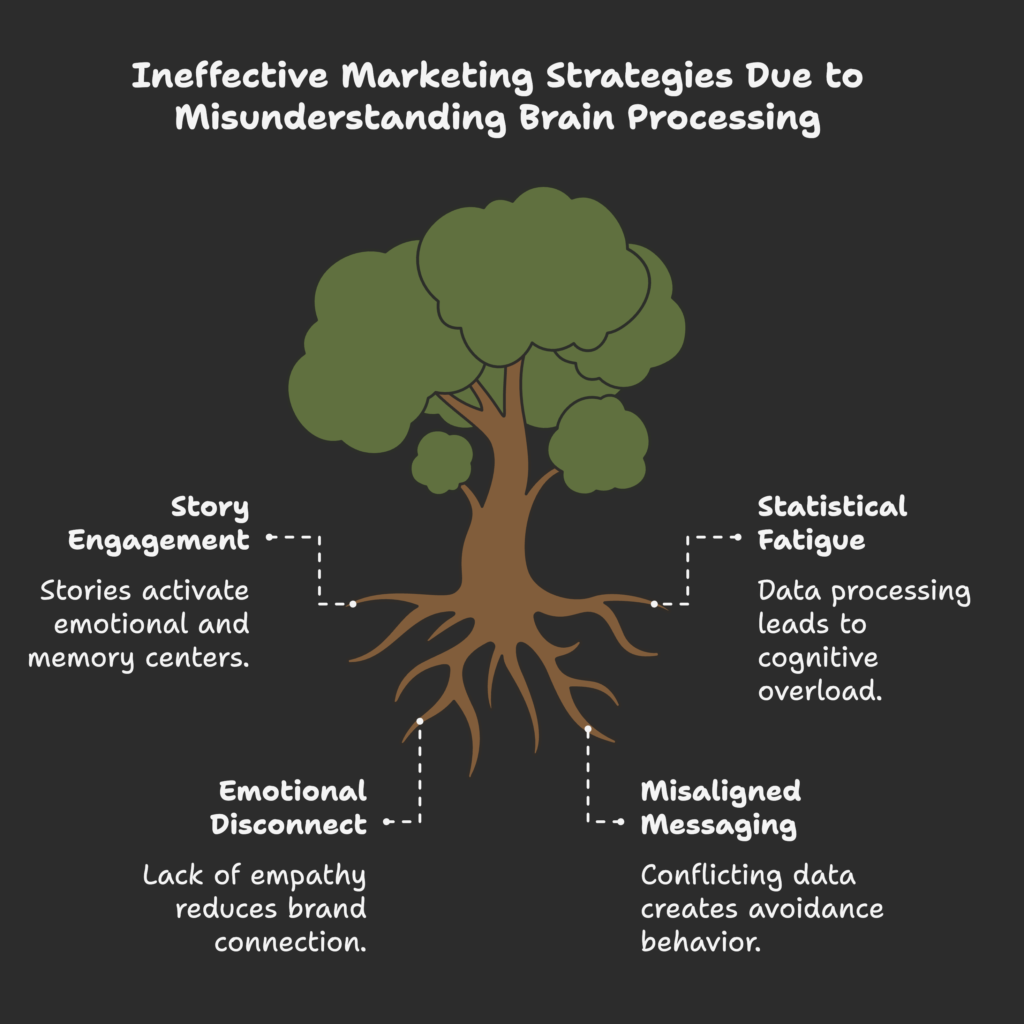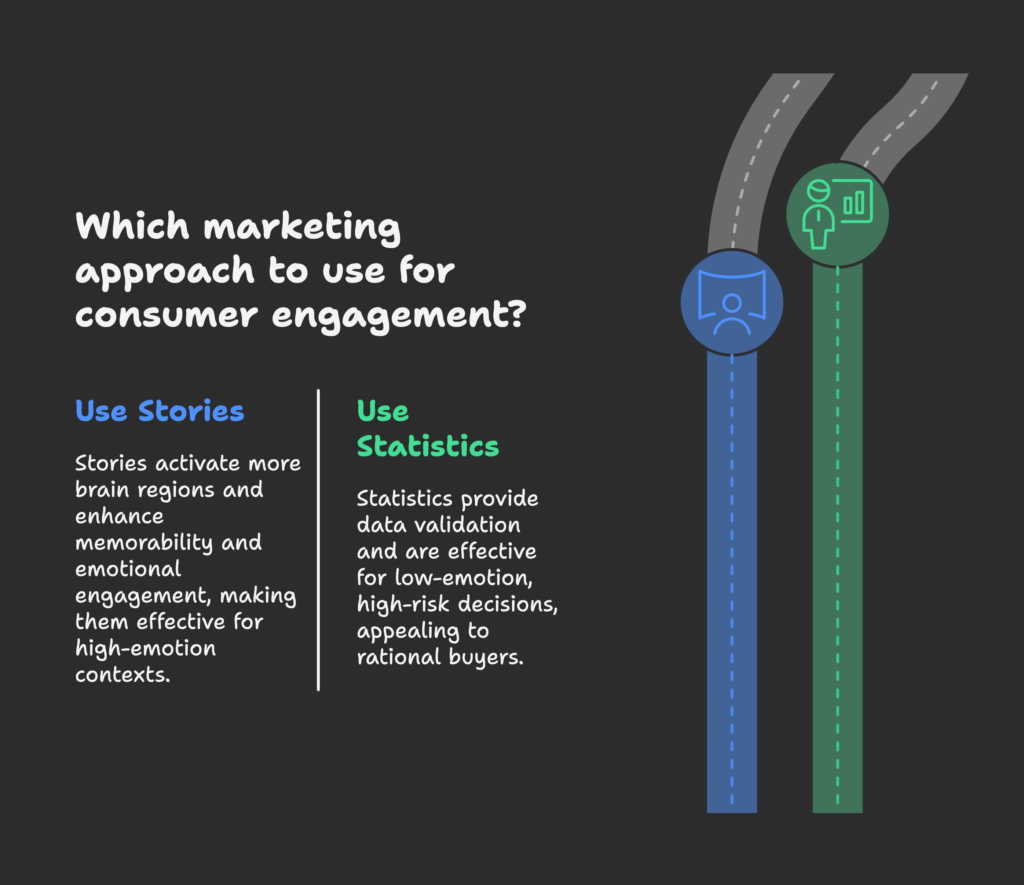Have you ever wondered why some marketing campaigns stick in your mind for years while others fade within minutes? Or why certain product stories make you reach for your wallet while impressive statistics barely raise an eyebrow? The secret lies not in your conscious preferences, but in the fascinating way your brain processes different types of information.
In a world where the average person encounters up to 10,000 marketing messages daily, understanding the neurological impact of your marketing strategy isn’t just helpful—it’s essential for survival. When you finish reading this article, you’ll discover:
- Why our brains are literally wired for stories (and how this evolved from prehistoric times)
- The surprising science behind why facts and figures often fail to convert
- Practical techniques to blend storytelling and statistics for maximum brain impact
- Real-world examples of brands that have mastered the neurological sweet spot
Ready to peek inside the consumer’s brain and discover the perfect balance of heart and mind in your marketing? Let’s dive in!
Introduction to Neurological Processing in Marketing
When it comes to how we process marketing messages, our brains aren’t the unified decision-makers we might imagine. Instead, they operate through two distinct pathways that respond very differently to stories versus statistics.
The Dual Pathways of Information Processing
Your brain has two primary systems for processing information:
- System 1 (Fast, Emotional): This is your brain on stories. It operates automatically and quickly, with little or no effort and no sense of voluntary control. When you hear a compelling story about a product, your amygdala (the emotional center of your brain) lights up, creating an immediate, subconscious response. This is why testimonials and case studies can be so powerful.
- System 2 (Slow, Analytical): This is your brain on statistics. It allocates attention to effortful mental activities, including complex calculations and logical reasoning. When you encounter data or specifications about a product, your prefrontal cortex engages in deliberate processing.
The most striking revelation? Research shows that a whopping 95% of purchasing decisions happen in System 1—the subconscious, emotional brain. This explains why even the most logical consumers can make seemingly illogical buying decisions.
Evolutionary Basis of Storytelling
Our preference for stories isn’t just a quirk—it’s literally encoded in our DNA. For thousands of years before written language, humans relied on storytelling to transmit survival knowledge from generation to generation.
Think about it: which would be more memorable to a prehistoric human?
- “Red berries with white spots have a 97% correlation with stomach illness when consumed.”
- “Remember cousin Og who ate the red berries with white spots? He was sick for three days and nearly died!”
The story format ensured critical information was remembered and shared. In the modern marketplace, brands have essentially become our new tribal storytellers, tapping into this ancient neural pathway.
The Rise of Data-Driven Marketing
Despite our evolutionary preference for narratives, the digital age has brought an explosion of data-driven marketing. Companies can now quantify almost every aspect of consumer behavior, from click rates to dwell time to conversion percentages.
This abundance of data has created a paradox: while marketers have more statistical ammunition than ever, consumers are experiencing unprecedented levels of statistical overload. Our attention economy simply doesn’t allow for processing the endless graphs, charts, and percentages thrown our way.
So what happens when these two worlds collide? Is your marketing budget better spent on crafting compelling narratives or compiling convincing data? The answer lies deeper in understanding how our brains process these different types of information. Let’s explore the fascinating neuroscience that explains why stories and statistics affect us so differently.
Theoretical Foundations: How the Brain Processes Stories vs. Statistics
To truly understand the power differential between stories and statistics in marketing, we need to peek under the hood and see how our brains physically engage with each type of information. This isn’t just theoretical—brain scanning technologies have given us remarkable insights into these processes.

Neuroscience of Storytelling
When you encounter a compelling story in marketing, several key brain regions spring into action:
- Posterior Cingulate Cortex: This area helps you visualize the narrative, essentially creating a mental movie of the story. When Nike shows you an underdog athlete overcoming obstacles using their products, this region helps you see yourself in their shoes.
- Medial Prefrontal Cortex (mPFC): The mPFC generates empathy and social connection. It’s why you might tear up during a heartwarming commercial even when you know it’s designed to sell you something. This region is crucial for building brand relationships.
- Amygdala: As your emotional control center, the amygdala encodes the emotional salience of the story. Strong emotional responses create stronger memory imprints, which is why emotionally charged marketing stories stick with you longer.
- Hippocampus: This is your memory formation center, and it loves stories. Research shows that facts wrapped in stories are remembered up to 22 times better than facts alone. The hippocampus converts narrative experiences into long-term memories.
The coordinated activation of these regions creates what neuroscientists call “neural coupling”—a phenomenon where the listener’s brain activity starts to mirror the storyteller’s brain activity. It’s the closest thing we have to mind-melding!
Neuroscience of Statistical Processing
Now let’s look at what happens when your brain encounters statistics and data:
- Dorsolateral Prefrontal Cortex (DLPFC): This region handles analytical evaluation of data, weighing evidence and assessing logical coherence. It’s your brain’s fact-checker.
- Intraparietal Sulcus: Specialized in numerical reasoning and risk assessment, this area helps you process quantitative information and compare values.
The challenge with statistical processing is cognitive fatigue. Unlike storytelling regions that can remain engaged for hours (think how long you can binge a good TV series), these analytical regions require significant glucose and oxygen to function and fatigue quickly.
This explains why reading a data-heavy whitepaper can feel exhausting while you can consume story-based content for much longer periods. Your working memory has limited capacity, and detailed statistics quickly overload it.
Key Neurochemical Differences
The chemical responses in your brain also differ dramatically between stories and statistics:
- Dopamine: Often called the “reward molecule,” dopamine gets released during emotionally resonant stories. It’s associated with pleasure, motivation, and memory formation—creating a positive association with the brand.
- Cortisol: This stress hormone can spike when you encounter conflicting statistics or data that challenges your existing beliefs. While some tension in storytelling can be engaging, statistical cognitive dissonance often leads to avoidance behavior.
- Oxytocin: Sometimes called the “trust hormone,” oxytocin is released when we experience empathy through relatable narratives. Airbnb’s “Belong Anywhere” campaign succeeded largely by triggering oxytocin release through stories of belonging and connection.
Now that we understand the fundamental differences in how our brains process these two types of information, we can explore their practical impact on consumer behavior. Ready to see how these neurological differences translate into real-world buying decisions? Let’s find out!
Comparative Impact on Consumer Behavior
Understanding brain activity is fascinating, but what marketers really care about is how these neurological differences influence actual consumer decisions. Let’s explore the measurable effects of stories versus statistics on key marketing metrics.

Memorability and Recall
Perhaps the most striking difference between stories and statistics is their impact on memory:
- Studies show that stories activate 7 times more brain regions than statistics, creating multiple neural pathways to the same information.
- Facts wrapped in stories show 22 times higher retention than bare statistics. This explains why you might forget a product’s technical specifications but remember its origin story for years.
- Airbnb’s “Belong Anywhere” campaign exemplifies this principle perfectly. Few travelers remember Airbnb’s impressive growth statistics, but millions recall their emotional stories of travelers connecting with local hosts and communities.
This memory advantage is particularly crucial in today’s crowded marketplace, where a consumer might encounter your brand dozens of times before making a purchase decision.
Persuasion and Decision-Making
The persuasive powers of stories versus statistics depend significantly on the decision context:
- Anecdotal Bias: Research shows that around 70% of managers prioritize stories over statistics in high-emotion contexts (like healthcare, education, or luxury purchases). A single compelling customer testimony can outweigh pages of performance data.
- Statistical Persuasion: Statistics tend to be more effective for low-emotion, B2B decisions or when the purchase involves significant risk. Technical buyers often require data validation, though they’re still influenced by narratives.
- Cultural context also matters enormously. Collectivist societies (like many Asian cultures) show stronger responses to story-based marketing that emphasizes community and belonging, while individualist societies may respond better to a mix of personal storytelling and supporting data.
The most effective approach recognizes that most purchasing decisions involve both emotional and rational components—they’re rarely purely one or the other.
Emotional Engagement
The emotional impact difference is where stories truly shine:
- Narrative-driven content increases purchase intent by up to 30% compared to purely informational content.
- fMRI studies reveal that emotionally engaging stories activate the brain’s reward pathways—the same regions that respond to actual product use or consumption.
- This neural “pre-experience” creates a powerful anticipation effect, where consumers already feel a connection to the product before purchasing it.
This explains why unboxing videos, customer testimonials, and “day in the life” content have become such powerful marketing tools—they leverage the brain’s tendency to mentally simulate experiences through storytelling.
Now that we understand the different impacts of stories and statistics on consumer behavior, let’s explore practical ways to apply this knowledge in your marketing strategy. Are you ready to discover the frameworks and techniques that turn these neurological insights into marketing magic? Let’s continue!
Strategic Applications in Product Marketing
Now comes the fun part: putting all this brain science to work in your marketing strategy. Let’s explore practical frameworks for leveraging both storytelling and statistics, along with innovative hybrid approaches that give you the best of both worlds.
Storytelling Frameworks
Not all stories are created equal when it comes to brain engagement. Here are three powerful frameworks proven to activate those key neurological pathways:
- Hero’s Journey: This classic narrative structure places your customer as the hero facing a challenge, with your product as the “magical aid” that helps them succeed. Apple’s legendary “Think Different” campaign masterfully positioned its products as tools for creative heroes changing the world.
- Sensory Layering: The more senses your story engages, the more brain regions activate. Coca-Cola’s marketing doesn’t just show people enjoying their product—it incorporates the distinctive sound of a bottle opening, the sight of condensation on the glass, and the sensation of refreshment, creating a multi-sensory story.
- Micro-Stories: In today’s social media environment, brands need to tell compelling stories in seconds, not minutes. These compressed narratives focus on a single emotional moment or transformation, perfect for platforms like Instagram or TikTok.
When crafting your story-based marketing, remember that relatability trumps perfection. Brain scans show stronger activation when consumers can see themselves in the story—which is why user-generated content often outperforms polished professional narratives.
Statistical Optimization
While stories may dominate emotional engagement, smartly presented statistics play a crucial role in building trust and validation. Here’s how to make your data work harder:
- Data Visualization: Transform complex statistics into intuitive infographics that reduce cognitive load. Our visual processing system is incredibly powerful and can grasp patterns in visualized data far more easily than raw numbers.
- Personalized Analytics: Generic statistics trigger much less brain activity than personalized data. Netflix’s recommendation engine succeeds by showing viewers statistics specifically relevant to their viewing patterns.
- Anchoring Effects: Strategic presentation of statistics can create powerful “anchors” that influence perception. For example, presenting your premium product alongside an ultra-premium version makes it appear more reasonably priced—a statistical framing that affects perceived value.
Remember that timing is everything with statistics. Brain studies show that data presented after emotional engagement has already been established is processed more favorably than data presented cold.
Hybrid Approaches
The most neurologically powerful marketing doesn’t choose between stories and statistics—it strategically combines them:
- Story-Data Fusion: This approach embeds key statistics within a narrative framework, giving the emotional engagement of stories with the credibility of data. Example: “After trying six different solutions without success (story), 92% of customers like Sarah saw results within two weeks (statistic).”
- Nike’s sustainability reports exemplify this approach perfectly—embedding environmental statistics within athlete journeys and product stories, making potentially dry data emotionally resonant.
- The optimal ratio appears to be around 70% story to 30% statistics for most consumer products, though this varies by industry and decision context.
Now that we have frameworks for creating brain-optimized marketing content, how do we actually measure its neurological impact? Let’s explore the fascinating tools and metrics that let us peek directly into the consumer’s brain as they engage with our marketing.
Measuring Neurological Impact
In the past, marketers had to guess at how their content was affecting consumers’ brains. Today, an exciting array of neuroscientific tools and behavioral metrics allows us to measure these impacts with remarkable precision. Let’s explore how brands are tracking the brain’s response to their marketing.
Neuroscientific Tools
These advanced technologies directly measure brain activity and physiological responses:
- fMRI (Functional Magnetic Resonance Imaging): The gold standard for brain activity measurement, fMRI scans show which brain regions activate during ad exposure. Major brands use fMRI to test whether marketing content activates the medial prefrontal cortex (for empathy) and amygdala (for emotional salience).
- EEG (Electroencephalography): More affordable than fMRI, EEG measures electrical activity on the scalp to create real-time emotional engagement scores. It’s particularly useful for tracking moment-by-moment responses to video content.
- Galvanic Skin Response (GSR): This measures subtle changes in skin conductivity that indicate subconscious emotional arousal. GSR can reveal when a marketing message triggers an emotional response, even if the consumer isn’t consciously aware of it.
These tools are increasingly accessible even to smaller brands, with specialized neuromarketing firms offering testing services at various price points.
Behavioral Metrics
If direct brain measurement isn’t in your budget, these behavioral metrics provide useful proxies:
- A/B Testing: Compare story-driven versus statistic-driven campaign performance across metrics like click-through rates, conversions, and engagement. This real-world testing often reveals surprising insights about your specific audience.
- Dwell Time: Narrative content typically generates 40% longer engagement times than statistic-heavy content. Measuring how long visitors interact with different content types can indicate their neurological engagement.
- Conversion Rates: Story-driven calls to action consistently show around 30% higher conversion rates than purely information-based CTAs. This difference directly reflects the greater emotional activation and memory encoding from narratives.
Combining multiple metrics provides the most complete picture of your marketing’s neurological impact.
Ethical Considerations
As we gain more power to influence consumers at a neurological level, ethical considerations become increasingly important:
- Cognitive Manipulation Risks: The repeated triggering of dopamine responses through emotionally manipulative narratives can potentially create unhealthy consumer relationships with products.
- Transparency Standards: Emerging best practices suggest disclosing when neuromarketing techniques have been used to optimize marketing materials, particularly for sensitive products like alcohol, gambling, or financial services.
- The most sustainable approach focuses on creating genuine value through your marketing—content that consumers would choose to engage with even knowing how it affects their brains.
Now that we understand how to measure neurological impact, let’s explore real-world examples of brands that have mastered these principles. Ready to see these brain-based strategies in action through compelling case studies? Let’s continue!
Case Studies
Theory is valuable, but seeing these neurological principles applied in the real world brings them to life. Let’s examine brands that have masterfully leveraged stories, statistics, and hybrid approaches to create brain-optimized marketing.
Success Stories
These brands have achieved remarkable results through story-focused approaches:
- Dove’s “Real Beauty”: This campaign challenged beauty stereotypes through emotional storytelling about real women’s experiences. The neurological genius was connecting Dove products with self-acceptance narratives that triggered oxytocin release (the “trust hormone”). The result? A 20% sales growth and unprecedented brand loyalty.
- Huawei’s Crisis Communication: When facing trust issues in Western markets, Huawei shifted from touting technical specifications to sharing stories of third-party validators and everyday users. This activated trust centers in the brain more effectively than security statistics ever could.
- Both campaigns succeeded by prioritizing emotional resonance over information density, activating the amygdala and hippocampus for stronger memory encoding.
Statistical Campaigns
Some contexts still benefit from statistics-first approaches:
- Volvo’s Safety Stats: Volvo’s long-running focus on safety statistics works because safety is an inherently emotional issue where data provides reassurance. Their “1 million lives saved” campaign successfully bridges statistical credibility with emotional impact.
- Meta’s Ad Analytics: Meta (formerly Facebook) sells its advertising platform largely on performance statistics, but presents these numbers through visualizations that reduce cognitive load and through personalized dashboards that increase relevance.
- These approaches succeed by making statistics accessible and contextually relevant, reducing the burden on the brain’s analytical centers.
Hybrid Innovations
The most neurologically sophisticated campaigns blend stories and statistics:
- Google’s Year in Search: This annual campaign masterfully weaves global search data (statistics) with human stories of resilience, discovery, and connection. The result activates both emotional and analytical brain regions, creating powerful engagement and brand affinity.
- Spotify Wrapped: Perhaps the perfect example of personalized story-data fusion, Spotify Wrapped transforms each user’s listening statistics into a unique, shareable personal narrative. The genius is making dry data (minutes listened, top artists) feel like an emotionally resonant story of your year.
- Both examples succeed by presenting statistics in a narrative framework that gives the data meaning and emotional context.
As technology continues to evolve, the possibilities for neurologically optimized marketing grow even more exciting. What innovations are on the horizon? Let’s explore the future of neuromarketing and how emerging technologies will shape the story-statistics balance.
Future Directions
The intersection of neuroscience and marketing is evolving rapidly, with new technologies promising even more sophisticated ways to engage consumers’ brains. Let’s explore what’s coming and how it will transform the story-statistics balance.
Emerging Technologies
These innovations will soon change how we create and deliver brain-optimized marketing:
- Generative AI: As AI systems like GPT-4 and beyond become increasingly sophisticated, they’re enabling dynamic story personalization at unprecedented scale. Imagine marketing narratives that adapt in real-time to individual consumers’ preferences, histories, and emotional states—creating perfect neurological engagement for each person.
- Neuro-Feedback Ads: Experimental systems are already using webcams to track facial micro-expressions and eye movements, adjusting marketing content in real-time based on neurological engagement signals. As this technology matures, ads might literally reshape themselves to better engage your specific brain.
- The most exciting developments combine multiple technologies—such as AR experiences that tell personalized stories while subtly incorporating product statistics in ways optimized for brain processing.
Ethical Frameworks
As our ability to influence the brain grows, so does the importance of ethical guidelines:
- Global regulations for neuromarketing are beginning to emerge, with the EU leading the way through GDPR-inspired policies that may soon require disclosure of brain-targeting techniques.
- Consumer education on cognitive biases is becoming increasingly important. As people become more aware of how marketing affects their brains, brands that are transparent about their techniques may actually gain trust advantage.
- Forward-thinking companies are developing internal ethical frameworks that balance effectiveness with responsibility—recognizing that manipulative neuromarketing may drive short-term sales but damage long-term brand relationships.
Cultural Adaptation
The neurological impact of stories versus statistics isn’t universal—it varies significantly across cultures:
- Research shows significant differences in how high-context cultures (like Japan or Brazil) versus low-context cultures (like Germany or Canada) process marketing information neurologically.
- The most advanced global brands are beginning to localize not just language and imagery, but the fundamental story-statistic balance of their marketing based on regional neuro-trends.
- This cultural neuromarketing represents one of the most promising frontiers for brands expanding into diverse global markets.
As we look to the future, the brands that will thrive are those that balance neurological effectiveness with ethical responsibility, creating marketing that engages the brain without manipulating it. Let’s wrap up with key takeaways and practical recommendations you can implement immediately.
Conclusion and Strategic Recommendations
We’ve journeyed deep into the brain’s response to marketing, exploring how stories and statistics trigger different neural pathways and influence consumer behavior. Now let’s distill this knowledge into actionable insights you can apply to your marketing strategy starting today.
Key Takeaways
- Stories and statistics affect fundamentally different brain regions, with narratives activating emotional and memory centers while statistics engage analytical reasoning areas.
- The most effective marketing doesn’t choose between heart and mind—it strategically engages both through a carefully balanced approach.
- The optimal ratio for most consumer products appears to be roughly 70% story to 30% statistics, though this varies by industry, product complexity, and target audience.
- Neurological engagement directly correlates with key marketing metrics including memorability, persuasion, emotional connection, and ultimately, purchasing behavior.
Implementation Checklist
Ready to put these insights into practice? Start with these steps:
- Audit your existing content for neurological alignment: Are you overwhelming consumers with statistics when stories would be more effective? Or are you relying solely on narratives when your audience needs data validation?
- Train your team in “neurocopywriting” techniques that blend emotional storytelling with strategic data presentation. This might involve workshops on storytelling structures, data visualization, and understanding cognitive biases.
- Experiment with A/B testing different story-statistic ratios for your specific products and audience segments. The neurological sweet spot may vary significantly depending on your market position and customer psychology.
- Consider investing in neurometric validation of your most important marketing assets. Even simple tools like eye-tracking or emotional response testing can provide valuable insights into how consumers’ brains are engaging with your content.
Final Thoughts
As the marketing landscape becomes increasingly crowded and sophisticated, neurological understanding offers a powerful competitive advantage. The brands that will thrive aren’t simply those with the biggest budgets or the flashiest creative—they’re the ones that most effectively speak the brain’s dual languages of narrative and evidence.
In the words of neuroscientist Antonio Damasio, “We are not thinking machines that feel; we are feeling machines that think.” Your marketing should reflect this fundamental truth about the human brain.
Remember: the future of marketing isn’t about choosing between stories and statistics—it’s about creating the perfect neurological symphony that engages both the heart and mind of your consumer.
Growth Reminder: Looking to put these neurological insights into practice in your e-commerce business? Shopify store owners can leverage the Growth Suite application to craft story-driven product descriptions, create data-backed promotional campaigns, and measure the neurological impact of different marketing approaches—all helping to significantly boost your sales and customer engagement.
References
- Smith & Kida (1991): Managerial decision-making biases. DOI:10.2307/258292
- Hamelin & Harcar (2020): Neuroscience marketing principles. PDF
- FutureProof Media (2023): Storytelling brain activation. Link
- Dufter (2021): Storytelling vs. statistics. Link
- LeapMesh (2024): Storytelling conversion metrics. Link
- Imran (2023): Neuromarketing case studies. LinkedIn
- Abraham (2023): Emotion in storytelling. Link
- ACS Media Kit (2023): Storytelling frameworks. Link
- Innovative Human Capital (2024): Evolutionary storytelling. Link
- Freling et al. (2020): Anecdotal bias meta-analysis. DOI:10.1016/j.obhdp.2020.01.006



